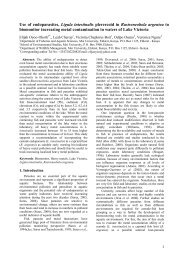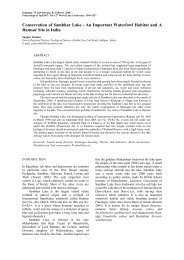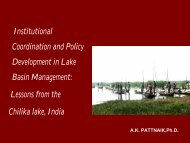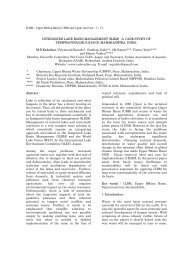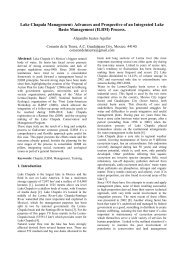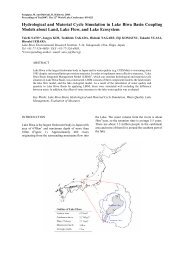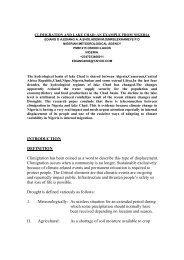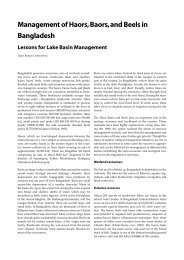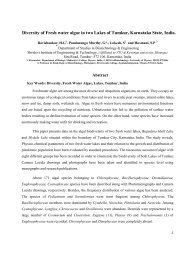THE EUTROPHICATION AND PHYTOPLANKTON BIODIVERSITY ...
THE EUTROPHICATION AND PHYTOPLANKTON BIODIVERSITY ...
THE EUTROPHICATION AND PHYTOPLANKTON BIODIVERSITY ...
Create successful ePaper yourself
Turn your PDF publications into a flip-book with our unique Google optimized e-Paper software.
<strong>THE</strong> <strong>EUTROPHICATION</strong> <strong>AND</strong> <strong>PHYTOPLANKTON</strong> <strong>BIODIVERSITY</strong><br />
OF SOME LAKES IN HANOI, VIETNAM<br />
Le Thu Ha<br />
Faculty of Biology, Hanoi University of Sciences, Vietnam National University, Hanoi<br />
Abstract<br />
The five small lakes such as: Thanh Nhan, Ba Mau, Phuong Mai, Giam and Hai Ba<br />
Trung, have been in the eutrophic level. The five large lakes such as: Xa Dan, Giang Vo,<br />
Thanh Cong, Thien Quang and Ngoc Khanh have been in the mesotrophic level<br />
Results of phytoplankton surveys, using only the criteria of presence or absence are<br />
shown that: Thanh Nhan lake has 39 species and sub-species of algae and Cyanobacteria<br />
Ba Mau lake has only 9 species belonging to 3 classes. The dominate of Euglenophyta<br />
shows that water in Ba Mau lake is enrichment nutrients. Xa Dan lake has 10 species and<br />
sub-species. Phuong Mai lake is in the algae blooming period by 10 species belonging to<br />
Chlorophyta, Euglenophyta and Cyanobacteria. Microcystis aerugiosa is the main<br />
component contributing to the algae blooming state in Giam Lake. Giang Vo and Ngoc<br />
Khanh lakes both have 24 species with fairly similar composition of species. Chlorophyta<br />
and Euglenophyta are seen in both lakes, especially representatives of Scenedesmaceae<br />
family and Phacus genus. 40 species were recorded in Thanh Cong lake and 35 species were<br />
recorded in Thien Quang lakes. Hai Ba Trung lake has 65 species.<br />
1. Introduction<br />
It is not by chance that Hanoi is referred to as “Lake City”. Throughout the ups and<br />
downs in different periods of its history, the number of lakes in Hanoi has changed. As the<br />
city becomes more urbanized, more land is required for the development of roads and<br />
buildings. However, Hanoi today still has a large number of large lakes, among which 24<br />
lakes in the urban Hanoi make up the total area of 647,55 ha, more than 10% of the total<br />
area of the urban Hanoi.<br />
In recent years, the speed at which the economy has developed is relatively fast.<br />
Besides the advantages, the problems caused by this economic development have led to<br />
many consequences, one of which is the alarming pollution level of the lakes. Most of them<br />
are “enrichment nutrients”, causing the decline of the water quality, as well as the ecology<br />
and biodiversity.<br />
*Address for correspondence.<br />
E.mail: lethuha17@yahoo.com. Tel: 04.5572605. Fax: 04.8582069
2. Methods<br />
Samples were collected in 2006, 2007 and 2008 from 10 lakes in Hanoi (Vietnam),<br />
including Thanh Nhan, Ba Mau, Phuong Mai, Xa Dan, Giang Vo, Giam, Thanh Cong, Hai<br />
Ba Trung, Thien Quang and Ngoc Khanh.<br />
Parameters of the water quality, including nine variables (temperature, pH,<br />
turbidity, dissolved oxygen-DO, biological oxygen demand-BOD5, chemical oxygen demand-<br />
COD, NH4, NO3, PO4). were measured by TOA, MERK and BOD-System OxiDirect<br />
equipments at laboratory of Ecology and Environmental Biology, Faculty of Biology, Hanoi<br />
University of Sciences [5].<br />
Algae samples were collected by phytoplankton net N o64 and Zooplankton samples<br />
were collected by zooplankton net N o5. All samples were kept in 4% formaldehyde solution<br />
and analyzed at the laboratory of Department of Botany and Microscope Laboratory and<br />
the laboratory of Department of Zoology, Faculty of Biology, Hanoi University of Sciences<br />
[1,2,3,4].<br />
3. Results and Discussion<br />
3.1. Assessment of water quality<br />
The ranges of values obtained at the sampling sites during the physic-chemical surveillance<br />
programme are shown in table 1.<br />
No Lakes<br />
1 Thanh<br />
Nhan<br />
Table 1. Means of water quality parameter values of the lakes<br />
Tem.<br />
( oC)<br />
pH<br />
Tub.<br />
(mg/l)<br />
DO<br />
(mg/l)<br />
BOD5<br />
(mg/l)<br />
COD<br />
(mg/l)<br />
NH4 +<br />
(mg/l)<br />
NO3 -<br />
(mg/l)<br />
PO4 3-<br />
(mg/l)<br />
28.9 8.0 - 8.5 4 - 10 3.2 - 5.6 36 - 43.5 100 - 112 3 - 10 7 – 10 1.25 - 5.0<br />
2 Ba Mau 28.5 7.6 - 7.9 78 - 101 1.0 - 3.0 77 - 87 97 - 104 8 - 10 3 – 5 7.3 - 10<br />
3 Phuong<br />
Mai<br />
28.7<br />
7.4 - 8.1<br />
31 - 57<br />
0.5 - 10.8 73 - 84 131 - 145 7.5 - 10 2 – 3 5.4 - 10<br />
4 Giam 28.5 7.8- 8.0 35 -54 2.53 – 3.7 65.3 - 74.0 112- 139.2 3.7 - 5 1 - 2.2 2.5 – 5.2<br />
5 Giang Vo 29.8 7.9 - 8.6 4 - 9 3.7 - 9.2 27.6 - 29 134 - 156 7 - 10 2 – 10 0.5 - 1.2<br />
6 Ngoc<br />
Khanh<br />
30.4 7.8 - 8.5 7 - 13 4 - 10.3 24.8 - 30 96 - 102 8 - 9 30 – 40 3.2 - 5<br />
7 Xa Đan 29.3 7.7 - 8.3 8 - 12 2.9 - 6.4 34.5 - 37.5 88 - 139 5 - 8 15 – 20 3.2 – 4.2<br />
8 Thanh<br />
Cong<br />
9<br />
Hai Ba<br />
Trung<br />
10 Thien<br />
Quang<br />
24 8.0 - 8.7 2.0 - 4.0 9.5 - 11.9 19.8 - 27.3 32 – 52.16 4.2 - 6.1 6.8 – 10.2 0.5 – 1.3<br />
24.5 7.4 - 7.8 8.0 - 10.0 3.3 - 6.0 29.0 - 35.0 45.0 - 60.0 7.3 - 9.6 15 – 20.1 1.6 – 2.8<br />
24.5 8.5 - 9.0 3.0 - 8.0 8.1 - 11.7 16.4 - 24.0 34.4 - 45.3 3.5 – 4.9 10 – 14.2 0.2 – 0.9<br />
TCVN 5942 [5] 9.0 80 > 2.0 < 25.0 < 35.0 1 15 1<br />
Remarks on the characteristics of 10 lakes analyzed based on the data in table 1:
- The five small lakes such as: Thanh Nhan, Ba Mau, Phuong Mai, Giam and Hai Ba Trung,<br />
have been in the eutrophic level. All these lakes are received domestic sewage and storm<br />
drainage without treatment.<br />
- The five large lakes such as: Xa Dan, Giang Vo, Thanh Cong, Thien Quang and Ngoc<br />
Khanh have been in the mesotrophic level. Because these lakes received only storm<br />
drainage, not received domestic sewage.<br />
- The DO values of all the eutrophic lakes were lest than 4.0mgl -1. The DO values of all the<br />
mesotrophic lakes were higher than 6.0mgl -1.<br />
- The BOD5 values ranged from 19.8mg l -1 (Thanh Cong lake) to 87.0mg l -1 (Phuong Mai)<br />
- The lowest COD values were recorded in Thanh Cong lake. COD concentration was 32mg<br />
l -1. And the highest COD values were recorded in Giang Vo lake. COD concentration was<br />
156mg l -1.<br />
- The high concentration of NH4-N and PO4 -P in water were recorded in the eutrophic lakes.<br />
3.2. Composition of Algae, Cyanobacteria<br />
Results of phytoplankton surveys, using only the criteria of presence or absence are<br />
shown in table 2. One hundred thirty nine species and subspecies of phytoplankton were<br />
recorded. They belong to 5 classes, they are Cyanobacteriophyta, Bacillariophyta,<br />
Cryptophyta, Euglenophyta and Chlorophyta [2,3].<br />
Table 2. Species composition of Algae and Cyanobacteria<br />
of the sampling lakes in Hanoi<br />
No Species Lakes No Species Lakes<br />
Cyanobacteriophyta Chlorophyta<br />
1 Oscillatoria homogenea Frộmy<br />
1,4,6,<br />
9,10<br />
73 Chlamydomonas chrysomonadis 8<br />
2 O. brevis (Kuetz.) ex. Gom. 2,4 74 Cladophora crispata 9<br />
3 O. rupicola Hansg. 1,7 75 Closterium parvulum Nag. 9<br />
4 O. formosa Bory ex. Gomont 3 76<br />
Crucigenia tetrapedia (Kirchn) W.et<br />
W<br />
1,8,9,10<br />
5 O. curviceps C.AG.ex Gom. 8 77 C. fenestrata (Schmid) Schmidle 7<br />
6 O. chlorina 8 78 C. retangularis 1,6,7<br />
7 O. irrigua 9, 10 79 C. quadrata Morren. 1,6,7,9,10<br />
8 O. tenuis AG. ex Gom. 8, 9 80 C. cambricum var. intermedium 1<br />
9<br />
Spirulina platensis (Nordst.)<br />
Geitl.<br />
2 81<br />
10 S. hanoiensis Duong. 10 82<br />
11 S. major Kuetz. ex Gomont 10 83<br />
12 Lyngbya circumcreta G.S.West 1 84<br />
13 L. aerugino-coerulea Kuetz. 1 85<br />
14 L. sp.1 1,4 86<br />
Scenedesmus acuminatus var.<br />
biseratus Reinsch<br />
S. acuminatus (Lagerh.) Chod. var.<br />
acuminatus<br />
S. quadricauda (Turp.) Brelis var.<br />
vesiculosus<br />
S. arcuatus (Lemm.) Lemm. var.<br />
arcuatus<br />
S. bicaudatus (Hanag.) Chod. var.<br />
bicaudatus<br />
S. bijugatus (Turp.) Kuet. var.<br />
bijugatus<br />
1,3,6,7,8<br />
1,3,6,7<br />
7<br />
1<br />
1,6,8,9,10<br />
1,6,7,8,9
15 L. sp 2 6 87<br />
16 Rivularia planctonica Elenk. 1 88<br />
17<br />
Merismopedia minima G.<br />
Beck.<br />
1,3,4,6,7,<br />
9,10<br />
S. bijugatus var. alternans<br />
(Reinsch) Hangg.<br />
S. quadricauda (Turp.) Brelis var.<br />
quadricauda<br />
89 S. denticulatus var.linearis Hansg. 1,9<br />
1,6,7,9<br />
1,6,8,9<br />
18 Microcystis aeruginosa Kỹtz. 2,5,9 90<br />
S. obliquus Kuetz. var. alternans<br />
Christ.<br />
7,8,9<br />
19<br />
M. pulverea f. minor (lemm.)<br />
Hollerb<br />
1,6,8,9,10 91<br />
S. obliquus (Turp.) Kuetz. var.<br />
obliquus<br />
3,8,9<br />
20 M. elegans A. Br. 9 92<br />
S. acuminatus (Lagerh.) Chod. var.<br />
acuminatus<br />
8,9,10<br />
21 M. punctata Meyen 8, 9, 10 93<br />
S. acuminatus (Lagerh.) Chod. var.<br />
elongatus<br />
9<br />
22<br />
Gloeocapsa minuta (Kutz.)<br />
Hollarb. Ampl.<br />
8, 9, 10 94<br />
S. bicaudatus var. intermedius<br />
(Chod.) Ergashev<br />
8<br />
Bacillariophycophyta 95<br />
S. bicaudatus var. skabitschevskii<br />
(Skabitsch.) Ergashev<br />
9<br />
23 Cyclotella sp. 4,6,7 96<br />
S. denticulatus Lagerh<br />
var.denticulatus<br />
9<br />
24 Navicula subtilissima Cl. 1,7 97 S. ellipsoideus Chod. 9<br />
25 N. sp. 6 98 S. hortobagyi (Hortob.) Ergashev 9<br />
26 Cymbella ventricosa (Kỹtz.) 6,10 99<br />
S. quadricauda var. abundans<br />
Kirchn.<br />
9,10<br />
27 Cymbella affinis Kutz. 8 100 Oedogonium sp 1,4,7,8,9,10<br />
28<br />
Gomphonema angustatum<br />
( Kỹtz.) Rabenh.<br />
9,10 101 Hyaloraphidium contortum 2<br />
29 G. parvulum (Kutz.) Grun. 8,10 102 Tetraëdron constrictum 7<br />
30<br />
G. quadripunctatum (Ostr.)<br />
Wisl.<br />
8, 10 103 T. lunula 3<br />
31 G. olivaceum (Lyngb.) Kutz. 8,10 104 T. trilobulatum 1,8<br />
32 G. tergestinum (Grun.) 10 105 T. caudatum 9<br />
33 Navicula confervacea Kỹtz 9,10 106 T. minimum 9<br />
34 N. cryptocephala 10 107 T. reticulatum (Reinsch.) Hansg. 9<br />
35 N. gracilis Ehr. 9,10 108<br />
T. trigonum (Naeg.) Hasnsg. var.<br />
trigonum<br />
9<br />
36 N. tuscula (Ehr.) Grun. 10 109 T. triangulare Korsch. 10<br />
37 N. exigua (Greg.) 8 110 Tetrastrum heteracanthum 9<br />
38<br />
Pinnularia interrupta f. minor<br />
Boye P.<br />
8 111<br />
T. staurogeniaeforme (Schroed.)<br />
Lemm.<br />
39 Stauroneis anceps Ehr. 10 112 Ankistrodesmus gracilis 1<br />
40<br />
Hantzschia amphioxys (Ehr.)<br />
Grun. var. compacta Hust.<br />
10 113 A. bibraianus (Reinsch.) Korschik 7,10<br />
41<br />
Nitzchia gracilis var. capitata<br />
Wisl. et Poretzky<br />
8 114 A. acicularis var. acicularis 1<br />
42 Nitzchia sublinearis Hust. 10 115 A. acicularis 10<br />
43<br />
Achnanthes gibberula Grun.<br />
var. interrupta<br />
8 116 A. angutus (Bern.) Korschik. 9<br />
Cryptophyta 117 Hyaloraphidium curvatum Korsch 8,9<br />
44 Cryptomonas ovata 6,7,8 118 Cladophora sp. 1,4,7,8,10<br />
45 C. erosa 1,8,10 119 Coelastrum microporum Naeg. 1,5,6<br />
46 C. sp1. 8 120<br />
Pediastrum tetras (Ehr.) Ralfs var.<br />
tetras<br />
1,6,9<br />
47 C. sp2. 10 121<br />
P. tetras var. tetraodon (Corda)<br />
Rabenh.<br />
1,8,9<br />
Euglenophyta 122 P. duplex Meyen var. duplex 1,8,9<br />
48 Euglena splendes Dang. 3,7 123 P. duplex var. reticulatum Lagerh 1,9<br />
9
49 E. elastica Prescott 2 124<br />
P. simplex var. duodenarium<br />
(Bailey) Rabenh.<br />
1<br />
50 E. viridis Ehr. 1,8 125<br />
P. biradiatum var. longecornutum<br />
Gutw.<br />
9<br />
51 E. oxyuris Schmarda 2 126<br />
P. boryanum (Turp.) Menegh. var.<br />
boryanum<br />
9<br />
52 E. sociabilis 6,9 127<br />
Schroederia spiralis (Printz.)<br />
Korchikow<br />
8,9,10<br />
53 Euglena acus 9 128 Staurastrum limneticum Schmidle 1<br />
54 E. acutissima 9 129<br />
Actinastrum hantzchii Lagerh. var.<br />
hantzchii<br />
1,3,5,6,7,8,9<br />
55 E. caudata 9 130 Chlorella vulgaris Beijerinck 1,3<br />
56 E. minima 9 131 Golenkinia pancispina 8<br />
57 E. polymorpha Dang. 8 132 Trebouxia arboricola Puymali 10<br />
58 E. proxima 9 133 Dictyosphaerium pulchellum Wood. 9<br />
59 E. rostrifera n. sp. 9 134 Franceia ovalis (France) Lemm. 9<br />
60 E. sp. 9 135 Euastrum sp. 9<br />
61 Phacus longicauda 1,9 136 Cosmarium phaseolus Breb. 9<br />
62 P. longicauda f. curta Lefevre 2 137<br />
Kirchneriella contorta (Schmidle)<br />
Bohlin<br />
63 P. tortus (Lemm.) Swin. 2 138 K. lunaris (Korchn.) Moebius 9<br />
64<br />
P. hispidulus f. suecicus<br />
(Lemm.)<br />
65 P. pleuronectes (Ehr.) Duj. 6<br />
66 P. mentaweiensis Conrad 7<br />
67<br />
P. platalea var. major de<br />
Poucques<br />
68 P. contortus Bourr. 1,6,7<br />
69 P. acuminata 8,9<br />
70<br />
Lepocinclis fusiformis (Carter)<br />
Lemm.<br />
2<br />
71 Lepocinclis ovum 9<br />
72 Trachelomonas volvocina Ehr. 1,3,6<br />
shown that:<br />
6,7 139 K. obesa (West) Schmidle 9,10<br />
7<br />
8,9<br />
1-Thanh Nhan; 2-Ba Mau; 3-Phuong Mai; 4-Xa Đan; 5-<br />
Giam;<br />
6-Giang Vo; 7- Ngoc Khanh; 8-Thanh Cong, 9-Hai Ba<br />
Trung;<br />
10-Thien Quang<br />
Results of phytoplankton surveys, using only the criteria of presence or absence are<br />
- Thanh Nhan lake has 39 species and sub-species of algae and Cyanobacteria. It has<br />
Chlorophyta that is dominated by families of Scenedesmaceae and Hyrodictyaceae.<br />
- Ba Mau lake has only 9 species belonging to 3 classes. The dominate of Euglenophyta<br />
shows that water in Ba Mau lake is enrichment nutrients.<br />
- Xa Dan lake has 10 species and sub-species. Phuong Mai lake is in the algae blooming<br />
period by 10 species belonging to Chlorophyta, Euglenophyta and Cyanobacteria.<br />
- Microcystis aerugiosa is the main component contributing to the algae blooming state in<br />
Giam Lake. It produces microcystin, the most common in Microcystis genus. It is a poison<br />
that can prevent the activities of enzyme protein phosphatase.<br />
- Giang Vo and Ngoc Khanh lakes both have 24 species with fairly similar composition of<br />
species. Chlorophyta and Euglenophyta are seen in both lakes, especially representatives of<br />
Scenedesmaceae family and Phacus genus.
- 38 species were recorded in Thanh Cong lake and 35 species were recorded in Thien<br />
Quang lakes.<br />
- Hai Ba Trung lake has 65 species. The dominate of Chlorophyta shows that water in Hai<br />
Ba Trung lake is enrichment nutrients.<br />
Acknowledgment<br />
We thank Bui Thi Hoa for kind help in sampling, Nguyen Thuy Lien for indentifycation and<br />
her helpfulcomments of phytoplankton diversity. This work was supported by the QT 05-24<br />
project (Vietnam National University)<br />
Reference:<br />
[1]. Dang Ngoc Thanh, Thai Tran Bai and Pham Van Mien, Taxonomy of freshwater<br />
invertebrates in North of Vietnam, Science and Technology Publish house, Hanoi, 1980<br />
(Định loại Động vật không xương sống nước ngọt Bắc Việt Nam).<br />
[2]. Duong Duc Tien, Taxonomy of Cyanobacteria in Vietnam, Agriculture Publish house,<br />
Hanoi, 1996 (Phân loại Vi khuẩn lam ở Việt Nam).<br />
[3]. Harold C. Bold, Michael J. Wynne, Introduction to the algae (structure and<br />
reproduction), Prentice- Hall, INC., Englewood Cliffs, New Jersey 07632, 1978.<br />
[4]. Macan, T.T and Worthington, E. B., Life in lakes and rivers. Science Paperback,<br />
London, 1968.<br />
[5]. Ministry of Science, Technology and Environment, The environmental standards of<br />
Vietnam, Vol 1: Water quality, Hanoi, 1995 (Các tiêu chuẩn nhà nước Việt Nam về<br />
môi trường, Tập 1: Chất lượng nước).



